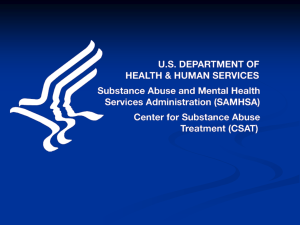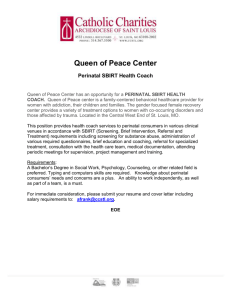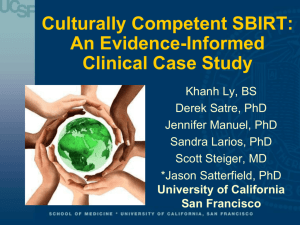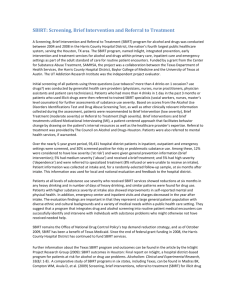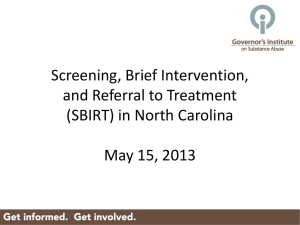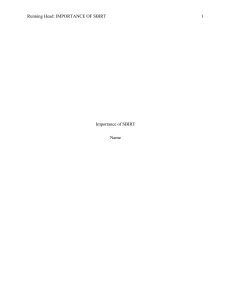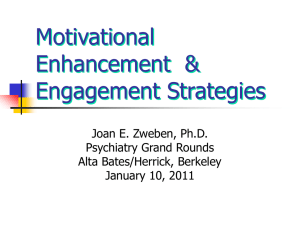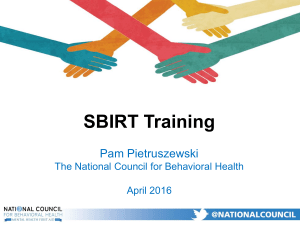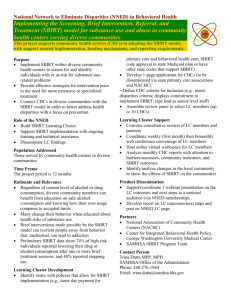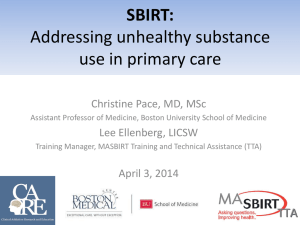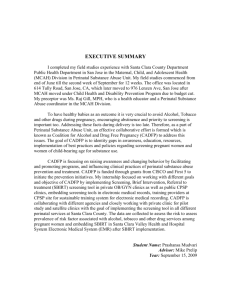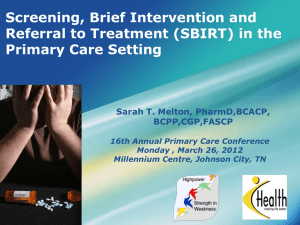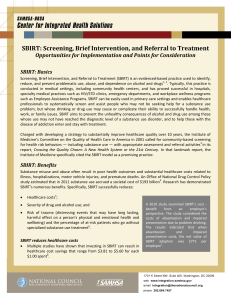Consider these facts… Drinker Distribution Screening, Brief Intervention, Referral, and Treatment
advertisement
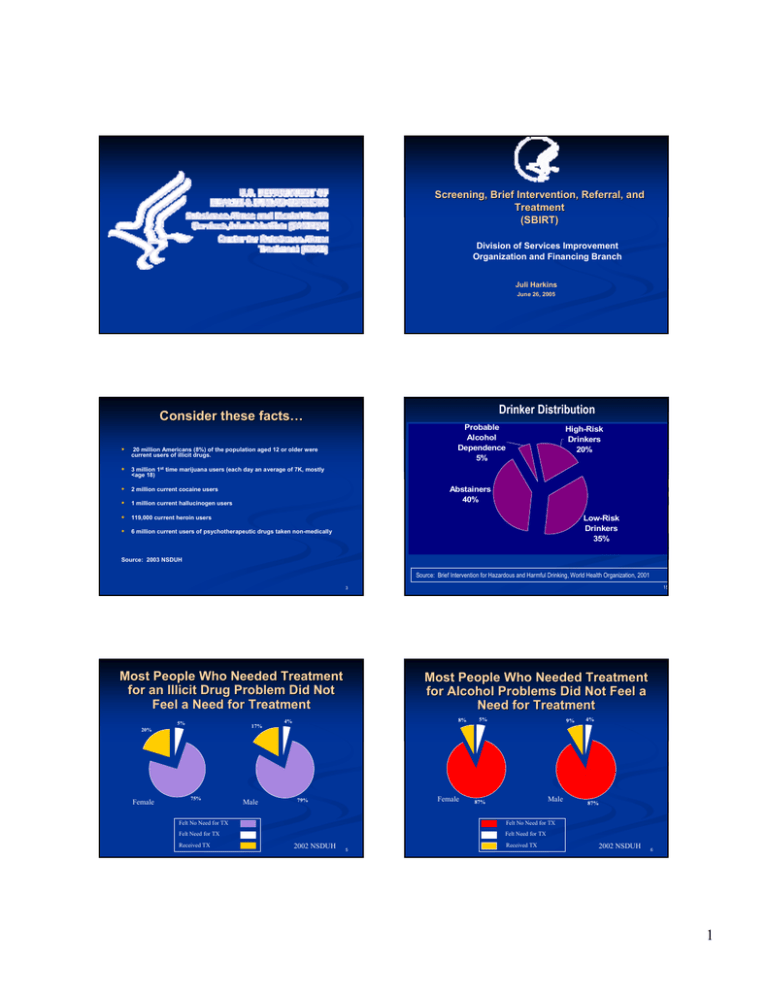
Screening, Brief Intervention, Referral, and Treatment (SBIRT) Division of Services Improvement Organization and Financing Branch Juli Harkins June 26, 2005 Drinker Distribution Consider these facts… 20 million Americans (8%) of the population aged 12 or older were current users of illicit drugs. 3 million 1st time marijuana users (each day an average of 7K, mostly <age 18) 2 million current cocaine users 1 million current hallucinogen users 119,000 current heroin users 6 million current users of psychotherapeutic drugs taken non-medically Probable Alcohol Dependence 5% High-Risk Drinkers 20% Abstainers 40% Low-Risk Drinkers 35% Source: 2003 NSDUH Source: Brief Intervention for Hazardous and Harmful Drinking, World Health Organization, 2001 3 Most People Who Needed Treatment for an Illicit Drug Problem Did Not Feel a Need for Treatment 8% 5% 9% 4% 17% 20% Female 15 Most People Who Needed Treatment for Alcohol Problems Did Not Feel a Need for Treatment 4% 5% 4 75% Male Female 79% Male 87% Felt No Need for TX Felt No Need for TX Felt Need for TX Felt Need for TX Received TX 2002 NSDUH 5 Received TX 87% 2002 NSDUH 6 1 Why SBIRT? SBIRT Encourages Moving from Research to Practice and from Science to Service in Medical Care Settings. The research suggests… Substance use and abuse have significant medical, social, and financial consequence to our society. Effective treatments exist but fewer than half of those who need treatment for substance use disorders receive the appropriate treatment. Early and brief intervention is more effective clinically and much more cost efficient than the traditional more intensive treatment necessary if the use progresses to addiction. Emergency services, chest pain, urgent care Trauma inpatient Primary care Dental services, pre-natal, breast exam clinics, adolescent clinics Excessive drinking and illicit drug use are often undiagnosed by medical professionals and go untreated, leading to a more chronic, severe condition. 7 Integrated Spectrum of Users and Services Prevention Generalist System Intervention Specialist System AtAt-Risk Users Abuse Disorder SBIRT Goals as a Conceptual Model and Planning Tool Increase access to clinically appropriate care for nondependent as well as dependent persons Link generalist and specialist treatment systems Combine prevention, intervention, and treatment toward a consistent Treatment NonNon-Users and Low Risk Users 8 continuum of care. Dependence Disorder Diminish barriers to access to care Increase the numbers of screenings and BI’s. Reduce Prevalence of Alcohol, Drug, and Medications Related Assessment, Assessment, Treatment, Support Brief Intervention and Boosters Disorders Building coalition between health care services and alcohol and drug treatment services Education, Information (Brief Advice) and Boosters Linkages by uniform decision rules; permeable boundaries 10 FFY 2003 Cooperative Agreement Awards made to 6 States and 1 Tribal Organization SBIRT: Core Clinical Components Screening: Very brief screening provides identification of substance related problems. Brief Intervention: Raises awareness of risks and motivation of client toward acknowledgement. Brief Treatment: Cognitive behavioral work with clients who acknowledge risks and are seeking help. Referral: Referral of those with more serious addictions. California Cook Inlet Tribal Council Illinois New Mexico Pennsylvania Texas Washington $3.485m $1.672m $3.500m $3.500m $2.970m $3.500m $2.970m Awards are renewable for up to five years, depending on performance and availability of funding. 11 12 2 Recommended SS-BIRT Awards FY 2003 SBIRT GPRA Summary (6/22/05) WA PA IL CA Area Target to Date Actual to Date Intake 162,657 198,806 Percentage 122.2% Screening 125,137 162,257 129.7% Brief Intervention 28,134 28,424 101.0% Brief Treatment 5,110 3,863 75.6% Referral & Treat 4,273 4,262 99.7% NM TX AK AI/AN 14 SBIRT Grants: SBIRT Evaluation: Expanding the State’s continuum of care to include screening,brief CSAT has funded Cross-site evaluation team: intervention, brief treatment, and referral services in medical and other community settings; Supporting clinically appropriate treatment services for nondependent substance users; Developing collaborative linkages between providers of SBIRT services and the more traditional substance abuse treatment providers to build resilience and facilitate recovery; and Identifying opportunities for system and policy change to improve access to care and ensure a life in the community for everyone. contractors Johnson, Bassin & Shaw (JBS), RTI International, and the University of Connecticut Health Center (UCHC) Purpose: to understand how SBIRT will work best in various settings and under different approaches and examine which SBIRT models offer the greatest potential to improve the U.S. healthcare system Evaluation Plan is under development 15 16 SBIRT ACTIVITIES Current Involvement: Uniform Accident and Sickness Policy and Provision Law Studies CMS Coding National Highway Transportation and Safety Administration Office of National Drug Control Policy American Society of Addiction Medicine Around the Corner: College University Grants New Fall Grants Worldwide Collaboration 17 3
